Выпуск 1, 2017
Математическое моделирование феноменов случайности и нечеткости в научных исследованиях. 1. Математические и эмпирические основы.
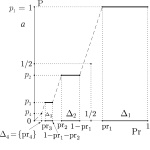
Математическое моделирование феноменов случайности и нечеткости в научных исследованиях. 1. Математические и эмпирические основы.
Ю. П. Пытьев
Рассмотрен вариант теории возможностей как математической модели феноменов случайности и нечёткости, позволяющий моделировать как вероятностную случайность, в том числе свойственную непредсказуемо эволюционирующим стохастическим объектам, вероятностные модели которых не могут быть восстановлены эмпирически, так и невероятностную случайность (нечёткость), свойственную реальным физическим, техническим, экономическим объектам, человеко-машинным, экспертным системам и др. Показаны принципиальные отличия рассмотренного варианта от известных вариантов теории возможностей, в частности, в математическом формализме и в его связи с теорией вероятностей, в его содержательной интерпретации и в приложениях, проиллюстрированных (в статье "Математическое моделирование феноменов случайности и нечёткости в научных исследованиях. 2. Приложения") на примерах решения задач оптимизации идентификации и оценивания, эмпирического восстановления нечёткой модели объекта исследования, решения задач анализа и интерпретации данных измерительного эксперимента и др.
Показать АннотациюThe Quasi-Exactly Solvable Problems for Two Dimensional Quantum Systems
The Quasi-Exactly Solvable Problems for Two Dimensional Quantum Systems
Liyan Liu$^1$, Chong Hou$^2$, Liqian Wei$^3$
In this paper, we study the quasi-exactly solvable problems for two dimensional quantum systems. By using the Bethe ansatz method, we obtain the general form of the quasi-exactly solvable potential. Then, we present several examples to give the specific forms of quasi-exactly solvable potentials. In the examples, some physical models of quasi-exactly solvable problems are re-exhibited.
Показать АннотациюГибридный метод решения уравнения Пуассона в области с металло-диэлектрическими углами
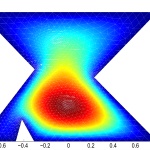
Гибридный метод решения уравнения Пуассона в области с металло-диэлектрическими углами
А.Н. Боголюбов, А.И. Ерохин, И.Е. Могилевский, М.И. Светкин
Рассматривается уравнения Пуассона в двумерной области, содержащей металло-диэлектрические углы звездного типа, в окрестности которых градиент решения может иметь особенность. Предлагается численный алгоритм решения данной задачи, основанный на методе конечных элементов и учитывающий асимптотическое поведение особенности решения в окрестности угловых точек.
Показать АннотациюНовый способ получения уравнения Карнахана-Старлинга и его обобщение
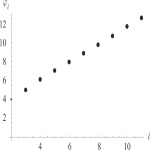
Новый способ получения уравнения Карнахана-Старлинга и его обобщение
П.Н.Николаев
В работе получено уравнение Карнахана-Старлинга для системы твердых сфер на основе использования метода Эйлера ускоренной сходимости рядов. Для этого вириальный ряд преобразован в новый ряд, коэффициенты которого слабо отличаются друг от друга даже при рассмотрении одиннадцати известных в настоящее время вириальных коэффициентов. К данному ряду применен метод ускоренной сходимости, который в результате позволяет получить уравнение Карнахана-Старлинга. В настоящей работе это уравнение впервые последовательно выведено на основе использования метода ускоренной сходимости. Данное уравнение обобщается на случай точного воспроизведения всех известных вириальных коэффициентов, а также асимптотического поведения свободной энергии при больших плотностях. Это позволяет описать с высокой степенью точности и метастабильную область. Используемый метод дает уравнение состояния для однородной фазы системы твердых сфер со степенью точности машинного эксперимента.
Показать АннотациюСпонтанное нарушение симметрии при конфайнменте атомов с условием Робина
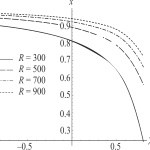
Спонтанное нарушение симметрии при конфайнменте атомов с условием Робина
К.А. Свешников$^1$, П.К. Силаев$^2$, А.В. Толоконников$^2$
В работе исследованы свойства основного состояния атома водорода в сферической вакуумной полости при общих граничных условиях “невылетания” (исчезновения потока через границу полости). Показано, что в отличие от запирания атома потенциальным барьером, в данном случае в зависимости от параметров полости атом может находиться как в устойчивом равновесии в центре полости, так и смещаться из центра к периферии, т.е. имеет место эффект спонтанного нарушения сферической симметрии. Построены фазовая диаграмма эффекта и зависимость смещения и энергии связи основного состояния атома от параметров полости. При этом деформационные свойства электронной ВФ для несимметричного искажения оказываются настолько нетривиальны, что ненулевое смещение возникает и в случае отталкивания электрона от границы полости.
Показать АннотациюСпины осколков вынужденного деления в рамках динамического подхода
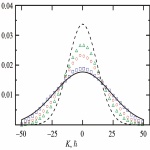
Спины осколков вынужденного деления в рамках динамического подхода
Д.О. Еременко$^{1,3}$, В.А. Дроздов$^3$, C.Ю. Платонов$^{1,3}$, О.В. Фотина$^{2,3}$, О.А. Юминов$^3$
Предложен новый подход к вычислениям средних спинов осколков вынужденного деления, учитывающий основные динамические аспекты этого ядерного процесса. В рамках предложенного метода проведен анализ экспериментальных данных по угловой и энергетической зависимостям средних спинов, а также по анизотропии угловых распределений осколков деления для реакции $^{16}$O + $^{232}$Th при $E_{cm} = (80 \div 150)$ МэВ. Определен диапазон значений времени релаксации для степени свободы, связанной с ориентацией оси симметрии делящегося ядра относительно полного углового момента, обеспечивающих согласованное описание экспериментальных данных
Показать АннотациюОсобенности скользящего взаимодействия быстрых электронов с диэлектрическими поверхностями
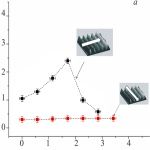
Особенности скользящего взаимодействия быстрых электронов с диэлектрическими поверхностями
К.А. Вохмянина$^1$, А.А. Каплий$^1$, А.С. Кубанкин$^{1,2}$, В.С. Сотникова$^1$, Т.Б. Никуличева$^1$, А.С. Чепурнов$^3$
В работе приводится анализ экспериментальных данных, полученных при исследовании механизмов скользящего взаимодействия пучков быстрых электронов с плоскими диэлектрическими поверхностями различных материалов, а также приведены новые экспериментальные результаты по исследованию скользящего взаимодействия электронов с энергией 10 кэВ с металлизированными структурированными поверхностями. Показано отличие процессов взаимодействия пучков быстрых электронов с плоскими и структурированными поверхностями.
Показать АннотациюРасчет одночастичных характеристик изотопов Pb в пределах близких к границам нуклонной стабильности в дисперсионной оптической модели
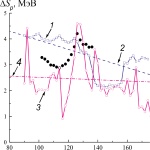
Расчет одночастичных характеристик изотопов Pb в пределах близких к границам нуклонной стабильности в дисперсионной оптической модели
О. В. Беспалова$^1$, А. А. Климочкина$^1$, А. В. Коротков$^2$, Т. И. Спасская$^1$
Сконструирован нейтронный и протонный дисперсионный оптический потенциал ядра 208Pb в области энергии от −70 до +60 МэВ. С его использованием вычислены данные по рассеянию и одночастичные характеристики, а также нейтронная и зарядовая плотности, среднеквадратичные радиусы и толщина скина ядра 208Pb. Достигнуто хорошее согласие с экспериментальными данными. Аналогичная методика применена при конструировании протонного дисперсионного оптического потенциала сферических и близких к ним изотопов Pb в пределах границ нуклонной стабильности. Расчет предсказывает тенденцию к расширению протонной частично-дырочной щели, соответствующей замыканию оболочки Z = 82, при приближении к границе протонной стабильности.
Показать АннотациюПолучение закрученного ультразвукового пучка с помощью фазовой пластины с угловой зависимостью толщины
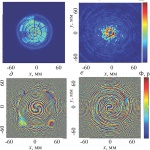
Получение закрученного ультразвукового пучка с помощью фазовой пластины с угловой зависимостью толщины
М.Е. Терзи, С.А. Цысарь, П.В. Юлдашев, М.М. Карзова, О.А. Сапожников
Закрученные волновые пучки – это пучки, переносящие момент количества движения. Особенностью таких пучков является кольцеобразный характер поперечного распределения интенсивности волны, при котором интенсивность на оси равна нулю. В настоящей работе предложен метод получения ультразвукового закрученного пучка с помощью соединения одноэлементного излучателя с неоднородной по толщине фазовой пластиной. Метод исследован теоретически и реализован экспериментально. При теоретическом анализе использовался метод расчета акустического поля, основанный на интеграле Рэлея. Эксперименты проводились в воде с использованием фокусирующего пьезокерамического источника частотой порядка 1 МГц, излучение которого пропускалось через 12-секторную фазовую пластину из оргстекла. Закрученность пучка обеспечивалась подбором толщины секторов. С помощью сканирования поля миниатюрным гидрофоном показано, что распределения амплитуды и фазы созданного волнового поля действительно соответствовали закрученному пучку. Продемонстрирована способность полученного пучка приводить во вращение рассеиватели, удерживаемые в фокальной области пучка.
Показать АннотациюАнализ растворенного органического вещества пресноводных озер Карелии обратно−фазовой высокоэффективной жидкостной хроматографией с одновременной регистрацией оптической плотности и флуоресценции
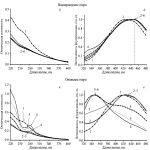
Анализ растворенного органического вещества пресноводных озер Карелии обратно−фазовой высокоэффективной жидкостной хроматографией с одновременной регистрацией оптической плотности и флуоресценции
Д.А. Хунджуа$^1$, С.В. Пацаева$^1$, О.А. Трубецкой$^2$, О.Е. Трубецкая$^3$
Спектрально-оптические свойства фракционированных компонентов растворенного органического вещества (РОВ) трех пресноводных озер Карелии были изучены с использованием обратно-фазовой высокоэффективной жидкостной хроматографии (ОФ-ВЭЖХ) с одновременным детектированием спектров поглощения и флуоресценции в режиме реального времени. Было показано, что препараты РОВ качественно сходны, но различаются количественным соотношением составных компонентов и содержат по крайне мере три типа флуорофоров: (1) гидрофильный «гуминоподобный» флуорофор(ы) с максимумом испускания в районе 420 нм и полосой поглощения 260-270 нм; (2) гидрофобный «гуминоподобный» флуорофор(ы) с максимумом испускания в районе 450 нм, спектр поглощения данного флуорофора не имеет характеристических максимумов в области от 220 до 400 нм; (3) флуорофор со спектром «протеиноподобного» типа с максимумом испускания в районе 340-350 нм, характерным для белков и пептидов, содержащих триптофан.
Показать АннотациюО допустимости некорректного выбора объема квантования
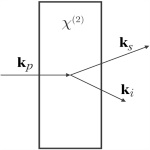
О допустимости некорректного выбора объема квантования
Белинский А.В.
Рассмотрены особенности выбора объеме квантования на примере приготовления квантового многомодового состояния в процессе параметрического рассеяния. Выбран небольшой, заведомо некорректный, объем, существенно упрощающий решение задачи, и который, тем не менее, дает правильные результаты, за исключением малозначительного фазового сомножителя, что показало сравнение с более точным, корректным (в смысле объема квантования), решением. Выявление этого факта позволяет надеяться на существенное упрощение решения квантовых задач, хотя бы в первом приближении.
Показать АннотациюИсследование потерь в магнитомягких магнитопластах в переменных магнитных полях
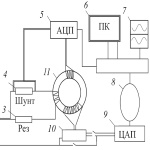
Исследование потерь в магнитомягких магнитопластах в переменных магнитных полях
Е.В.Милов, И.А. Сипин, В.Н. Милов, А.С. Андреенко, И.А. Балан
Проведены экспериментальные исследования потерь энергии при частотном перемагничивании в магнитомягких магнитопластах и промышленно выпускаемых электротехнических сталях. Исследования проводились на ряде образцов магнитопластов, отличающихся технологией изготовления и образцах листовой электротехнической стали различной толщины. Статические и динамические магнитные свойства образцов измерялись на вибрационном магнитометре и специально изготовленной установке, соответственно. Установлено, что исследованные в работе образцы магнитопластов имели относительно высокий уровень гистерезисных потерь, связанные с высокой коэрцитивной силой достигающей 4-5 Э. В то же время, потери на перемагничивание вследствие токов Фуко в магнитопластах существенно ниже, чем в электротехнических сталях. Результаты измерений показали, что при высоких частотах перемагничивания, в частности при использовании в высокооборотных электродвигателях, магнитопласты могут быть конкурентоспособны в сравнении с электротехническими сталями.
Показать АннотациюВзаимодействие полиэлектролитных микрогелей сополимеров N-изопропилакриламида с водными растворами алцианового синего
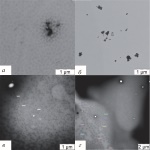
Взаимодействие полиэлектролитных микрогелей сополимеров N-изопропилакриламида с водными растворами алцианового синего
Д. В. Богдашкина$^1$, К. Э. Дашян$^1$, Е. Е. Махаева$^1$, С. С. Абрамчук$^2$
Исследовано влияние температуры на поведение микрогелей на основе гомополимера поли(N-изопропилакриламида) (ПНИПА), сополимера N-изопропилакриламида с метакрилатом натрия (ПНИПА/МАNa), стиролсульфонатом натрия (ПНИПА/CCNa) и винилсульфонатом натрия (ПНИПА/ВСNa). Проведен сравнительный анализ коллапса макро- и микрогелей при изменении температуры. Исследовано взаимодействие гелей ПНИПА, ПНИПА/ССNa, ПНИПА/ВСNa и ПНИПА/МАNa с алциановым синим. Показано, что сорбция красителя приводит к агрегации противоположно заряженных микрогелей. Эффективность сорбции зависит от природы ионогенных звеньев. Сорбция красителя микрогелями ПНИПА/ССNa выше, чем сорбция в соответствующих макрогелях. Абсорбция АС микрогелями ПНИПА/МАNa меньше абсорбции красителя макрогелями аналогичного состава, а также ниже, чем микрогелями ПНИПА/ССNa. Особенности взаимодействия связаны со структурой полимерной сетки микрогелей.
Показать АннотациюРегистрация броуновской релаксации магнитных наночастиц с помощью ВТСП СКВИДа
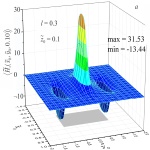
Регистрация броуновской релаксации магнитных наночастиц с помощью ВТСП СКВИДа
О.В. Снигирев$^{1,2}$, И.И. Соловьев$^3$, А.С. Калабухов$^4$, М.Л. Чухаркин$^4$
Выполнен анализ чувствительности безразделительной схемы иммуноанализа с использованием функционализированных магнитных наночастиц (МНЧ) и чувствительного ВТСП СКВИД-магнитометра. Сигнал от образца объемом 100 мкл с концентрацией 1 мг/мл в поле 7.5 нТл составил 20 мФ$_0$. При полосе усреднения 1 Гц для СКВИДа с уровнем шума интерферометра 1х10$^{-5}$ Ф$_0$/Гц$^{1/2}$ отношение сигнал/шум равное 1 будет получено в разовом измерении без накопления сигнала при концентрации 0.5 мкг/мл, что позволяет получить чувствительность в диапазоне 50 нг/мл при временных затратах в 100 с на точку в частотном спектре.
Показать Аннотацию
